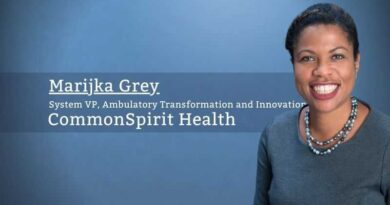A PATIENT-CENTERED FRAMEWORK FOR HEALTH SYSTEM INTEROPERABILITY
By Kristin L. Preihs, MPH, CHES, CQIA, Director of Clinical Quality & Funded Partnerships, The American Hospital Association (AHA)
I started my career in a rural public health department in southern Illinois, where interoperability often relied on impromptu phone calls and other person-to-person connections. Even with comparably modest resources and technology, the emergency and day-to-day operations of that local community health coalition was (and still is) formidable, well-connected and impactful.
Those early experiences in rural health instilled in me the importance of cross-sector interoperability, which functions best when aligned with current community readiness, better interpersonal communications and user-friendly technology.
Hospitals and health systems utilize some of the most advanced networks of interoperability in all health care. But interoperability must be more than just quickly getting translatable data from point A to point B. So how do the systems deployed by our field support the best choices and outcomes for the individual or community? How do we scale this technology without dehumanizing the process? And how do we pace new connections to be in-step with the unique communities in which systems will be used?
Fundamentally, this means aligning interoperability with a positive patient and community experiences, in alignment with third-party imports or other system-to-system algorithms. It also means threading this framework of observation into the fabric of all health care systems.
Community Readiness
At the AHA, we often hear from our members – 80% of the nation’s hospitals and health systems – that agency-specific, mission-critical systems need to be able to relay information to all community stakeholders during a public health event, such as a response to a disaster.
I have been on the ground in emergencies, from all-team drills to actual active shootings, and it can be difficult in these intense moments to decipher the deluge of messages being thrown around. Trauma centers, emergency departments (ED) and first responders can only digest so much information during an emergency event. Therefore, community response systems should be geared to prioritize crucial information in real time and lay formatting. Which responders are closest and available? How many people are on site? Where are the wounded being taken? Where are ED facilities at capacity? Where is there surge capacity?
According to FEMA, one way to strengthen systems and mitigate loss in these situations is to focus on wireless communications through a framework of “day-to-day, mutual aid, and task force interoperability.”
To see the importance that minutes, even seconds, can make in these situations, look no further than recent mass casualty events where often times the most significant factor for living or dying comes down to quickly identifying the capacity and resources most available to treat those in need, often through processing large amounts of ever-changing information.
Quality Data
In addition to community readiness, we repeatedly see that strong health care coalitions are a blend of robust data mixed with humans, where the users of interoperable systems have familiarity with the systems they use. Recent advancements in data aggregation are a move in the right direction for health care, and on the path to linking to the quality of life for the individual.
Perhaps this is because the conceptualization of data means different things to different people, and the field can now be encouraged to think differently on who owns the management of these data systems and how we can shift these complex pieces of information to then give options to the patient as well as the providers.
The pandemic has presented health care with an opportunity to reimagine surveillance and reporting mechanisms, including considerations towards the usage and storage of electronic health records (EHR). Whether it is conveying lab results, analyzing patient flow, or even mapping out a continuum of care, providers are increasingly responsible for juxtaposing lofty community health objectives while simultaneously reducing overhead costs. It then becomes critical, sometimes literally, to have flexible interoperability strategies that address this environment.
Many of the barriers to cross-sector data sharing can be overcome by bringing the right people to the table, establishing effective relationships, and cultivating trust among all relevant stakeholders.
Purposeful Communications
The COVID-19 pandemic also connected external systems to each other in new and exciting ways. Stand-up vaccination centers often require rapidly cycling information between health systems, public health departments, National Guard units, public transportation, commercial realtors, and so on. Truly a marvel of modern interoperability that might help the field reimagine the role of private-public partnerships and data-sharing.
A recently published paper by the Urban Institute underscored this sentiment that people skills and coalition-building are as important as technical skills, and that “many of the barriers to cross-sector data sharing can be overcome by bringing the right people to the table, establishing effective relationships, and cultivating trust among all relevant stakeholders.”
The AHA has the privilege of working with vast and varied collaborators, from large federal partners to public health agencies to academic institutions. The AHA’s members, and in turn, the communities served by our members, have benefited throughout the pandemic from these well-designed and effective cross-sector partnerships.
Through collectively shared resources, humanistic data and purposeful communications, we can move toward safer and healthier communities through forward-thinking techniques, such as cross-sector community collations, patient-centered data and inclusive communications.



